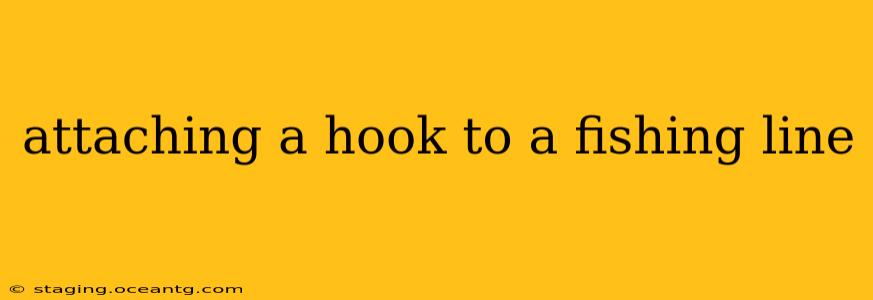Fishing is a rewarding pastime, but it all starts with properly rigging your gear. One of the most fundamental skills is knowing how to attach a hook to your fishing line. While it seems simple, mastering this technique ensures a secure connection, preventing frustrating losses of fish and tackle. This guide will cover various methods, addressing common questions and ensuring you're ready for your next fishing adventure.
What are the different ways to tie a fishing hook?
There are numerous knots for attaching a hook to a fishing line, each with its own strengths and weaknesses. The best knot depends on your line type (monofilament, braided, fluorocarbon), hook size, and the type of fishing you're doing. Here are a few popular and reliable options:
The Improved Clinch Knot: A Versatile Choice
The Improved Clinch Knot is a go-to for many anglers due to its strength, simplicity, and versatility. It works well with most line types and hook sizes.
- Pass the line through the eye of the hook: Leave a tag end of about 4-6 inches.
- Wrap the line around the hook shank: Make 5-7 wraps, keeping the wraps tight and close together.
- Pass the tag end through the loop: Created near the eye of the hook.
- Moisten the knot: Tighten carefully, ensuring the wraps are snug against the hook shank. Trim the excess tag end.
The Palomar Knot: Extremely Strong and Secure
The Palomar Knot is known for its exceptional strength and reliability, making it ideal for larger fish and heavier lines.
- Double the line: Pass the doubled line through the eye of the hook.
- Make a loop: Form a loop with the doubled line.
- Pass the loop over the hook: Bring the loop down over the hook shank.
- Pass the loop through the double line: Pull the loop tightly through the loop on the hook shank.
- Moisten and tighten: Carefully tighten the knot, ensuring it's snug against the hook eye. Trim the excess.
The Uni Knot: Ideal for Braided Line
The Uni Knot is particularly well-suited for braided lines, as it holds exceptionally well and minimizes line slippage.
- Pass the line through the eye of the hook: Leave a 6-8 inch tag end.
- Make 5-7 turns around the line: Wrapping the tag end around the standing line, near the hook eye.
- Pass the tag end through the first wrap: Tucking it closely against the main line.
- Moisten and tighten: Carefully wet the knot and pull the line and tag end firmly to tighten. Trim the excess.
Which knot is best for beginners?
For beginners, the Improved Clinch Knot is generally recommended. It's relatively easy to learn and master, providing a strong and reliable connection for most fishing situations. Practice tying it several times before heading out to the water to build confidence and ensure you can tie it quickly and efficiently.
How tight should the knot be?
The knot should be tight enough to hold securely but not so tight that you damage the line. Moisten the knot before tightening to reduce friction and prevent breakage. After tightening, gently pull on both the line and the hook to ensure the knot is secure. If it feels loose, retie it.
What if my knot slips?
If your knot slips, it's likely due to improper tying, insufficient tightening, or using the wrong knot for your line type. Carefully examine your knot-tying technique and try a different knot if necessary. Consider using a knot-tying tool or watching a video tutorial for a step-by-step demonstration.
How do I choose the right hook for my fishing line?
The appropriate hook size depends on the species of fish you're targeting, the size of the bait or lure, and the strength of your line. Use a hook that's proportionally sized to your bait and line to ensure secure hooksets and prevent breakage. Larger hooks generally require heavier lines.
What are some tips for tying a strong knot?
- Use sharp hooks: Dull hooks can increase the risk of line slippage.
- Use clean lines: Avoid using lines that are frayed or damaged.
- Practice regularly: Consistent practice will help you become more proficient and confident in your knot-tying skills.
- Watch videos: Numerous videos are available online demonstrating knot-tying techniques in detail.
By mastering these techniques and understanding the nuances of each knot, you'll enhance your fishing success and reduce frustrating losses of tackle. Remember, practice makes perfect! So grab your line, hooks, and get tying!
